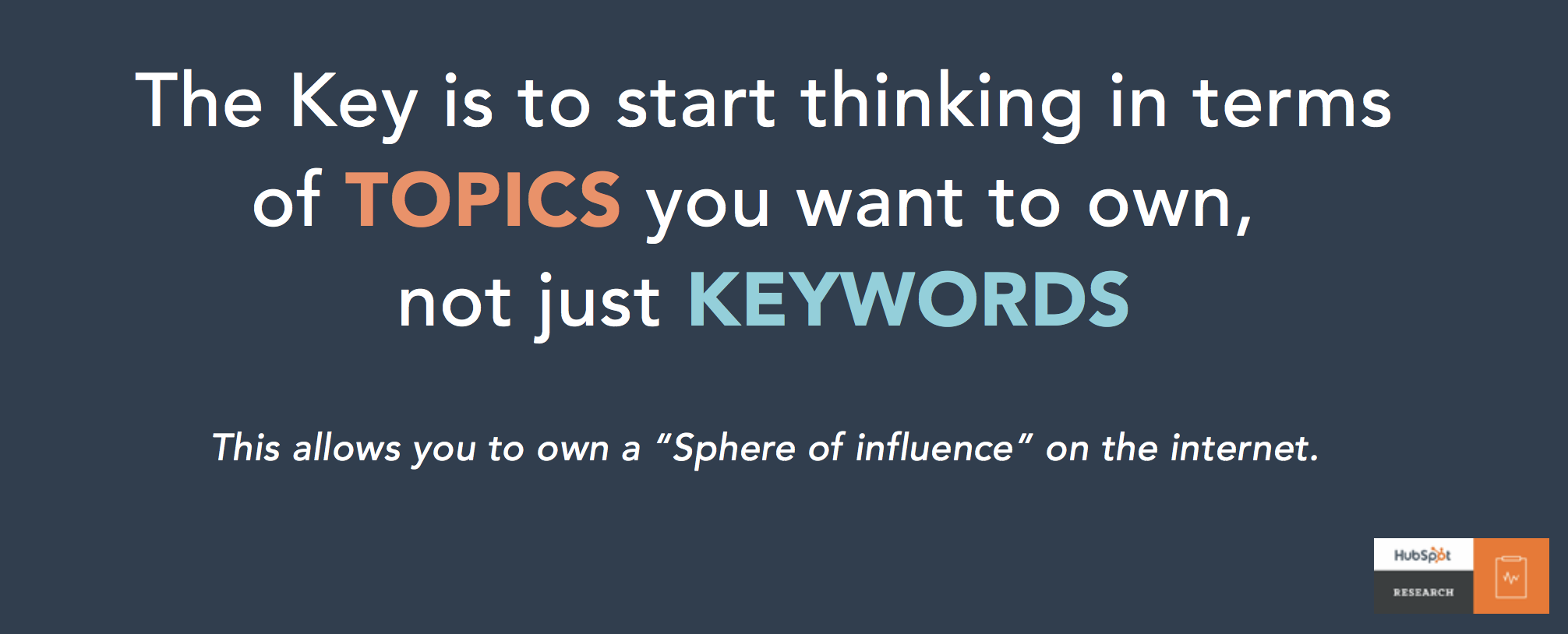HubSpot’s Topic Clusters is the best SEO tool of 2018. In 2013, Google introduced the Hummingbird update, which marked the decline of keywords as the predominant SEO strategy.
The algorithm could interpret phrases and questions that users typed into the search box instead of relying solely on keywords to produce search results.
When Google launched RankBrain in 2015, the world of SEO underwent another major shakeup.

The machine-learning algorithm can interpret users’ search queries based on context and past search behaviors to display the most relevant results.
With such personalization of search results, keyword rankings have become more fluid, and it’s more challenging to guarantee a certain positioning on SERPs.
SEO strategies have moved away from solely focusing on keywords. Instead, they place emphasis on tactics. Examples include internal linking, quality backlinks, and topic-based website structure to signal relevancy to search engines.
What does this mean for content marketers? What should you do to stay on search engines’ radar and improve your SEO ranking?
Our friends at Hubspot have done some legwork and pioneered the use of “topic cluster” to signal relevance while making it easy for search engines to crawl your site and understand your content.
Why Is Using Topic Clusters Good For SEO?
Topic clusters are a collection of interlinked articles or pages around one umbrella topic.
A topic cluster is created by identifying an umbrella topic as the focus of a pillar page. You’ll include links to other pages (e.g., blog posts) on your website to provide detailed and focused content on the sub-topics.

Creating topic clusters is an effective technique to improve the SEO of a website:
Topic Clusters and Internal Links
When you link other pages on your website to a pillar page, the internal links establish relationships among the content so search engines can understand the overall hierarchy of the information on your website.
When a piece of content ranks well, every page linked to it benefits as well. Topic clusters can create this “rising tide lifts all boats” effect to improve SEO rankings for all similar content on the site and even help you own multiple SERP positions for a single keyword.
Context and Semantic Relationships
Unlike discrete keywords, a topic cluster signals to search engines the breadth and depth of your website content.
Search engine algorithms, such as Google’s RankBrain, reward clear website structure and orderly linking with higher SERP placement.

Optimized For Questions
As users are getting more comfortable with entering complex questions into search boxes, your content should reflect how they ask questions in order to signal relevance to search engines.
You can increase the SEO ranking of your pillar pages by phrasing the copy and anchor links in a way that your ideal audience would pose their questions.
Topic Clusters and User Intent
A pillar page gives you the opportunity to provide the context that addresses user intent, which describes what users are looking for when they enter a search term into Google.
By creating content that addresses a specific user intent, you’re more likely to attract the right traffic to your website. These visitors are more likely to engage with your content, signaling to search engines that you’re offering relevant information.
Reduced Bounce Rate
A well-structured pillar page that illustrates the depth and breadth of relevant information available helps keep visitors on your website to explore your content.
This, in turn, improves SEO by increasing the number of pages viewed, lowering bounce rate, and increasing dwell time — all of which signal relevancy to search engines, help improve your ranking, and create a positive feedback loop to increase traffic.
How To Optimize Topic Clusters To Improve SEO
Creating content to support topic clusters can be quite an undertaking. (Want to make this easier? Here’s how we can help.) Here’s how to get the most out of the time and resources you invest in building topic clusters:
Topic Clusters and Identifying Content Gaps
“Content gap” refers to the keywords or search terms that your competitors are ranking for and driving traffic with, but you aren’t.
First, audit the assets you already have. Then, associate them with relevant keywords. That’s the quickest way to create new content or reposition existing information to bridge content gaps.
Next, you can target keywords with high commercial intent to help attract visitors that are most likely to convert.
In addition, look for “low-hanging fruit,” such as phrases or long-tail keywords for which you can exercise your domain authority to rank high on SERPs.
Research Your Ideal Customers’ Most Common Questions
Questions that your ideal audience asks frequently during their searches offer insights into what individual cluster pages you should create.
These questions should reflect the problems your audience faces, relate to the topic(s) you want to be known for, and align with the outcome of your products or services delivered.
You can search on sites like Quora or Yahoo Answers to see what questions your ideal customers are asking.
Use the exact wordings your audience uses when searching to inform the titles of your articles and anchor text. Then, you’ll signal relevance to search engines and improve the SEO ranking of the pillar page.
Refine On-Page SEO of the Pillar Page
The pillar pages should be the focus of your SEO efforts. And as such, make sure they’re optimized for search engines:
- Use H1 tags to highlight the topics and include the keywords in the page URL.
- Include a definition of the topic to increase the chances that the page will rank for “featured snippets” on Google’s search results. This will not only propel your link to the top of SERPs but also attract more attention to the content.
- Use H2 tags to highlight the subtopics. They should demonstrate the relationships between the key topics and these linked pages to search engines.
- Include relevant internal and external links on the pillar page to signal relevance to search engines.
Put Topic Clusters to Work
Using topic clusters is an effective way to improve your website’s SEO when implemented strategically.
Creating a topic cluster can be a time-intensive endeavor. Make sure you do the research and plan out the content strategy so you can maximize the ROI.
In addition, consider outsourcing your content production effort to high-quality writers so you can launch your topic clusters in a timely manner without stretching your internal team too thin or compromising quality.
Last but not least, make your pillar page, and sub-topic content go father by keeping them evergreen. Periodically revisit and update the information to make them timely and relevant.
